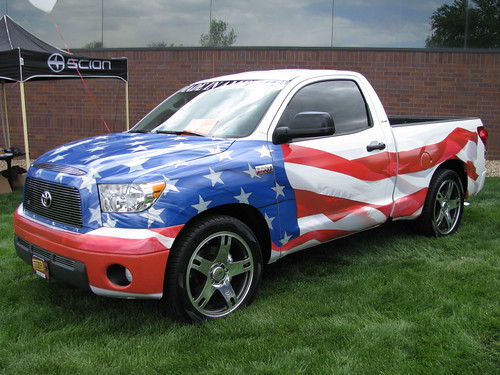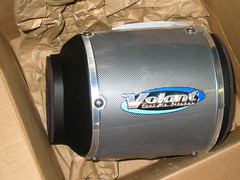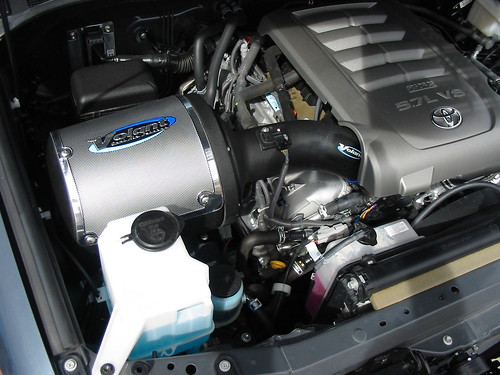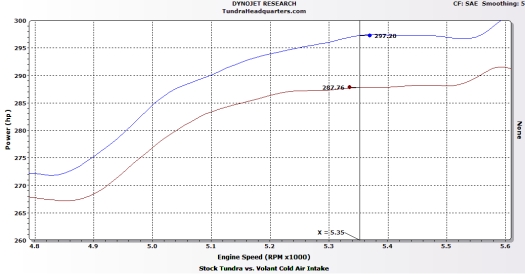 All Entries in the "Tundra Videos" Category
All Entries in the "Tundra Videos" Category
Rejected Toyota Superbowl Ad
Here’s a Toyota Superbowl TV ad that DIDN’T make the cut:

Spoiler – it’s a fake! What do you think – funny or just plain stupid?
TRD Supercharged Tundra Test Drive VIDEO
We visited Stevinson Toyota East last night in Aurora, CO (just outside Denver) and managed to test drive their Made In The USA Toyota Tundra. It’s a 2008 Tundra Regular Cab 2wd SR5 with the sport package, and the 5.7L V8 (of course). It also includes TundraRacing.com’s 2″ lowering kit, a complete set of carriage works grilles, a custom exhaust, and custom American flag vinyl work.

Stevinson Toyota East in Aurora, CO has created this Tundra to showcase their customization skills.
Sweet Zero to Fifty Five Tundra Video
Nice video of Will Travis racing his blue 07′ Reg. Cab.
Find more videos like this on TundraHeadquarters Social Network
I like the smell of burning rubber in the morning. Smells like…victory.
Product Review: Volant Cold Air Intake
We found out about the Volant’s new cold air intake for the 5.7L Tundra on TundraTalk.net, a nice forum for Tundra owners. After reading a few positive reviews from forum members, we contacted Volant and asked them if they might be interested in allowing us to review their product. They gladly accepted, and a brand new cold air intake arrived at our door.
 Our first impressions of the Volant intake were positive. Opening the package, we were amazed at just how simple this kit is. There’s the air box, duct, filter, some clamps, a hose connector, and some nuts and bolts. The air box’s chrome surface (see photo) is covered with plastic film to protect the finish as you install the kit — a nice touch. There’s also a brochure and some very rudimentary instructions.
Our first impressions of the Volant intake were positive. Opening the package, we were amazed at just how simple this kit is. There’s the air box, duct, filter, some clamps, a hose connector, and some nuts and bolts. The air box’s chrome surface (see photo) is covered with plastic film to protect the finish as you install the kit — a nice touch. There’s also a brochure and some very rudimentary instructions.
Speaking of instructions, installation is brutally simple. This has definitely got to be one of the highlights of this kit. Simply remove the stock air filter, engine cover, loosen a couple of clamps, unplug a couple of hoses, remove a couple of bolts, and the factory box is out of the truck. Next, you assemble the air box, bolt it into place, and reconnect all the hoses. One complaint we have – and it’s minor – is that the instructions themselves are pretty poor. They tell you how to get the job done, but we think someone should go through them and fill-in a couple of the blanks. The quality of the instructions themselves is also lacking — they look like they were made on an old zerox machine. Finally, the pages of instructions were actually stapled in the wrong order. Like we said, it’s a minor complaint — install is really easy — but the value of the kit might be a little higher if the instructions were higher quality (both in material and clarity).

Volant Air Intake Toyota Tundra Installation video
One of the other problems we have with this kit has to do with Toyota’s engine cover. First of all, in Volant’s defense, the piece of plastic that is supposed to “look like” an engine is stupid. It’s just there so that when a salesman opens the hood of the truck, he doesn’t forget the engine size and the customer can nod appreciatively and say “yes, that’s the 5.7L alright”. Basically, the engine cover is completely useless. Anyways, the problem here (and it’s minor) is that Volant’s air intake takes up some of the space that the engine cover needs to rest in. Volant provides a higher stud for the engine cover to attach to, but it’s not as solid as the factory setup. It’s not a big deal — the engine cover doesn’t do anything, doesn’t support anything, and really doesn’t need to be attached very tightly — but it would be nice if they had a solution that was a little more clever.
Fit and finish on the rest of the kit is excellent – the air box is flush against the fender and completely sealed so that only cool outside air can make it into the engine. [We’ve since been informed that the kit doesn’t completely seal against the fender. There is a small gap. Our tests indicate the gap doesn’t effect performance, but it should be noted.] This is a major selling point for Volant – they have studies that show most air boxes (both OEM and after market) let hot engine gases seep into the air the engine breathes, raising the air’s temperature and thus decreasing performance.
We have to say that the Volant kit looks awesome — it’s much more impressive than the factory air box and it looks a lot nicer than other air intakes we’ve seen. Sure, looks aren’t everything, but who doesn’t like to show off a cool accessory under the hood?

The air filter inside this kit is also a selling point for Volant. Unlike many competing companies, Volant’s PowerCore air filter is not made from cotton gauze. Instead, hundreds of staggered flutes catch 99.95% of the particulates that can damage your motor, and it does so without needing to be oiled periodically. Volant warranties their PowerCore air filters for 4 years or 100k miles, and they offer their filters in sizes that are compatible with air intakes from K&N, AEM, etc. We like the idea of a dry filter (cleaning and re-oiling filters is never fun or interesting), and we are intrigued by Volant’s claim that their filter allows better flow while catching more particulate matter.
So let’s get down to brass tax — how did the intake perform? When we first started the truck, we were amazed at how quite the Volant intake is. Whether sitting at idle or cruising down the highway, we didn’t notice any additional noise from under the hood. However, when you floor the throttle, you can hear the engine sing. Without exaggeration, you just can’t help but smile under full throttle. The sound is so pleasing to the ear, it’s like driving a race car. Very cool. We’d have to say the price of the kit might just be worth the sound alone.

Sounds of the Volant Air Intake for the Toyota Tundra – watch the video to hear the intake in operation.
Additionally, we noticed faster throttle response. Before, our test vehicle hesitated slightly on changes in throttle. With the Volant intake installed, response was almost instantaneous. The truck also felt quicker, both from a dead stop and as we accelerated on the highway. Overall, the kit seemed to make a big difference and it felt very good to drive.As far as horses are concerned, Volant claims the kit will add as much as 21hp to your Tundra’s 5.7L engine. They’ve even got the dyno graph to prove it. Looking closely at Volant’s graph, it looks like the air intake added about 14 hp at 5000 rpm, and nearly 18 hp at 5300 rpm. Our own results basically mirrored that result, but with lower magnitude. We recorded an 8 hp gain at 5000 rpm, and about 10 hp at 5350 rpm. Considering our base truck was making about 287 hp that day, and that the base truck in the Volant test was making nearly 300, we’re thinking that better conditions might have yielded better results (at least for our tests). But, like any cold air intake kit, the manufacturer’s estimates are always a little optimistic. Nonetheless, the difference we felt in power before and after was substantial. We think you can plan on seeing a gain of at least 5-10 hp, with some owners experiencing the full 21 hp Volant reports.
Click for larger view.
All in all, we like the Volant kit. It looks good, sounds good, drives good, and improves performance. We’re extremely confident in telling current Tundra owners that the Volant kit will add power. Like we said in our Tundra air intake guide, the factory air intake is pretty decent. But if you’re looking for a little more power, a more aggressive sounding truck (at least on WOT), or if you want to maximize horsepower gains from other accessories, installing a cold air intake makes sense.
Bottom Line: We really like the look and sound of the Volant kit. Installation is a breeze, and engine performance and throttle response were noticeably improved. We like Volant’s dry air filter, and we’ve read a lot of positive user reviews of the product. We do think the instructions could be a little nicer, and we wish they would have come up with a better way to accommodate the factory engine cover, but overall we will recommend this kit. Be sure to shop around before buying, as we found prices ranging from $360 to more than $500. NOTE: After completing this review, we learned that the kit does not seal against the fender completely. Our tests indicate the kit does add power, and we still like the look and sound, but it must be noted that the kit’s “fit and finish” is not as nice as we first reported. We’re not going to revoke our endorsement because of this issue because the kit does add power — we’ve proven that thru testing — but make sure you get this kit for discount.
Here’s a link to the least expensive Volant Cold Air Intake System we found for the new Tundra.
All Known 2007 Toyota Tundra Problems
Here’s a list of all the known problems with the 2007 Toyota Tundra. We’re not trying to tear the truck down or anything – we love it – we just want to make sure everyone knows what’s going on.
1) 5.7L Camshaft Failures
This is EASILY the most publicized problem with the new Tundra, but we think it was completely been blown out of proportion. Toyota said that this had only happened 20 times. We think it might have been slightly higher than that, but not by much. Since the original news story broke, very little has been heard about any more failures. Many doom sayers predicted the Tundra’s sales would collapse because of this “HUGE” issue, but the Tundra has never sold better. Confidence in Toyota quality remains high, as it should be, and the 5.7 camshaft issue is actually a non-issue.
2) Highway Bed Bounce
This problem is very odd. Because of the specific characteristics of the Tundra’s bed and frame, it is possible to induce a self-amplifying oscillation of the back-end of the truck. Amazingly enough, this can occur at highway speeds as the bed bounces over expansion joints in the roadway. Here’s a video:
Here’s a different video shot on a California highway. At this time, Toyota has not announced a fix. While all trucks exhibit some type of bed bounce on concrete highways with lots of expansion joints, Tundras seem to be worse than normal. Adding weight to the bed and/or a trailer helps, and some other fixes include air suspension and custom leaf springs. The best solution might be to wait and see if Toyota comes up with something official. Finally, if you can drive faster or slower than the harmonic frequency (observed at 55-65 mph) the vibration is vastly reduced. Try using that as an excuse when a cop is writing you a speeding ticket…
3) The stereo shutting off by itself
Of all the problems to have in the world, this one is pretty small. Occasionally, for no apparent reason, a small number of stereos in brand new Tundras have shut off all by themselves. Evidently, this is due to a short in the stereo itself. Toyota is aware of the problem and will replace your stereo as part of the warranty. We’re not 100% sure, but we can’t imagine this problem won’t be fixed in the 2008.
4) One of the air vent’s louvers won’t stay pointed downwards
This problem is actually kind of humorous, so we decided it might be fun to mention. The vent to the right of the driver, due to the effects of air-flow and gravity, has a tendency to creep upwards. In other words, you turn on the A/C, point the vent towards your mid-section, and within a few minutes the louvers have worked themselves upwards so that now the air stream is pointed towards your face. The smartest fix we heard of was to attach a book clip (you know, the black plastic and wire clip) to one of the louvers in such a way to keep it from moving. You could always ask your dealer to fix it, but they would have to remove part of your dash to do so. The book clip seems so much easier.
5) The seatbelt warning chime
A lot of people have complained about the seat belt warning chime. If you take your seat belt off for just a few seconds (say to get out of the truck to get the mail) your warning chime will go off. Also, if you are hauling something in the front passenger seat that weighs more than about 40 lbs, the weight sensor in the passenger seat will think there is a passenger sitting in the seat. If this cargo isn’t buckled in, you’ll get to hear the warning chime. There are lots of solutions to both — check out our article on the Tundra’s annoying seat belt buzzer.
6) Not getting the mileage on the sticker
In our opinion, this issue doesn’t really belong on this list. As long as people buy new vehicles, there will always be some that don’t get the mileage printed on the sticker. First of all, the mileage indicated is an average, meaning half will get more and half will get less. Second, the testing process used to determine those mileage numbers is, well, ridiculous. This isn’t a reflection on Toyota either — the EPA came up with this test nearly 30 years ago. It involves driving VERY slowly with the A/C off and not exceeding 54mph on days ending in “y” with your head cocked at a 17 degree angle…you get the idea. It’s not very applicable to today’s driving. If you’re looking for ways to improve your Tundra’s gas mileage, we wrote about gas mileage earlier this month. But don’t let stories you hear about Tundras getting poor gas mileage scare you off — just know that the mileage printed on the sticker is an estimate.
7) The Tundra is “too nice”
We’ve also heard of new Tundra owners being accused by their relatives (typically domestic truck owning in-laws) of having stuff that was “too nice” and “showing off.” We’re not sure what it is about, but it seems the Tundra gives people the impression that you’re better than them.
Any problems you’ve had that aren’t mentioned here? Tell us about them! We kind of made that last one up btw.
Search terms people used to find this page:
- https://tundraheadquarters com/all-known-2007-toyota-tundra-problems/
- 2007 toyota tundra problems
- 2007 tundra problems

